Speaking out: Dr Joanna Young challenges prescribed fire practices
Living on a farm at Walpole gave Dr Joanna Young the perfect opportunity to explore the surrounding Walpole Wilderness Area. Tingle trees, red flowering gums and natural vistas are some of what she loves to see. In recent years she has been working with local community groups to document and counter damage to the area’s biodiversity.
Joanna has expertise and interests in forest pathology, forest management and conservation. Her internationally recognised research career was focused on understanding the epidemiology of Phytophthora dieback and other forest tree diseases. She is a former member of the State Conservation Commission and has also advised the Environmental Protection Authority on dieback and ecologically sustainable forest management.
Here’s Joanna, sharing some of her knowledge and passion about the wonderful Walpole Wilderness Area, as well as her concerns about the impacts of current prescribed burning practices.

Story by Dr Joanna Young
While working in the jarrah forest on dieback research, I met and married my husband Ross and moved to Walpole in 1988. I had the good fortune to live on a lovely farm with old growth red tingle (Eucalyptus jacksonii) in the back paddock. It is beautiful forest and my two daughters often played there as children. I still remember one of my revelations about Walpole while walking the hills of the farm. I looked down on the town and realised its uniqueness: a town surrounded by a national park.
Not long after I arrived in Walpole I joined the fledgling Walpole Nornalup National Parks Association, which had been formed in 1987. This community organisation has done an amazing amount of work focusing on biodiversity conservation in the high rainfall corner of the south-west, and we’ve had lots of fun doing it. There have been many discoveries and countless projects, studying everything from spiders and fungi to spraying banksias to try to protect them from Phytophthora dieback. And out of that is the reward of many good friendships.
In 1991, over thirty years ago, the Parks Association ran a forum on the fire ecology of red tingle. These magnificent, tall trees with prominent trunk buttressing and a wide girth, exist only in a tiny area around Walpole, Nornalup and Bow Bridge. Because of the vulnerability of their buttresses to fire, there was already real interest in and concern about the impacts of prescribed burning. This is even truer today with climate change — red tingles are a locally endemic species with Gondwanan origins (a long-ago era, when the south-west was a wetter rainforest environment) so their ecosystems are doubly vulnerable to drying and increased frequency of fire.

Close to our farm, there’s an area of tingle forest in the Walpole-Nornalup National Park that has been burned repeatedly, largely by prescribed burns: 1967, 1980, 1983, 1987 wildfire, 2006 and 2017. In areas like these we are losing the older trees, the habitat trees, and we’re seeing structural change in the forest.

Stretching away from our farm to the north is the impressive expanse of the Walpole Wilderness Area (see map below). This area embraces several national parks, including Shannon, Mt Frankland, Mt Roe and Mt Lindesay, as well as Walpole-Nornalup. Since I first started exploring this country, particularly the granites, my awareness and appreciation of its Aboriginal cultural values has grown enormously. Many very special places are yet to be documented and protected; some I believe have been disturbed in ignorance.

This country has many other features that make it so special to me. Within its nearly 350 000 hectares, are large areas that are unspoilt in many ways — they’ve never been cleared or exploited for minerals or timber — so the opportunities to explore areas of great natural beauty seem unlimited. I find space, peace, nature and feelings of well-being after long walks to coast, river or granite. In every walk I discover something new to me, and I love trying to read the landscape ecology — what’s growing with what and why, and how does the whole place function. The local ecology is complex with rapid changes in the woodland, wetland and forest types over short distances.
But thirty-five years on from my arrival in Walpole, something is really disturbing the peace. It concerns the ongoing impacts of large-scale, very hot and frequent prescribed burning in the Walpole Wilderness Area. A burn that took place late last year offers a powerful example.
A very large (15,000 hectare) prescribed burn was conducted in one of the core wilderness areas in Mt Roe/Mt Frankland national parks (see map above). It was a long way from any settlement and the last prescribed burn in the area was in 2009, which escaped. This 2022 fire also escaped and a further 10,000 hectares was ignited. The whole fire was devastating in its intensity and scale. It burnt everything, including fire-sensitive peat and granite systems, paperbark swamps, and forests of karri, marri, and jarrah, scorching their canopies. It also ran back over areas that had been burnt in a previous escaped burn, just 13 years prior, which isn’t long when compared to the many years it takes for ecosystems to recover fully.
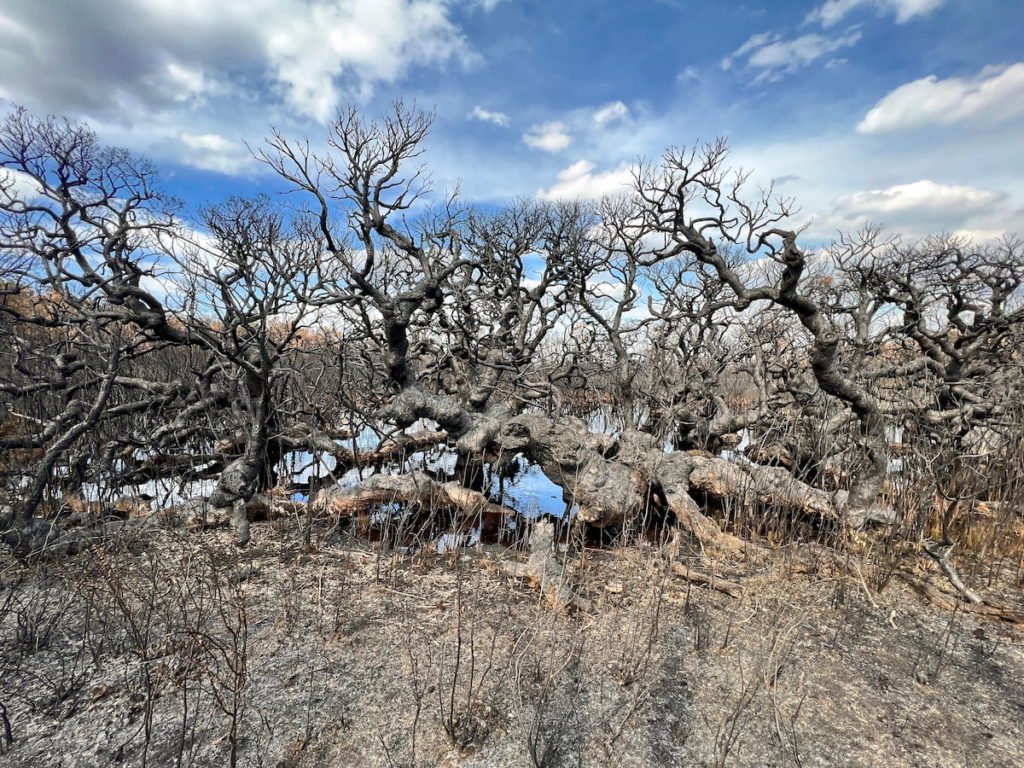
Recently, we’ve collected information on the flight paths taken for the aerial ignition of this burn, which you can see in the map below. This rather shocking image shows the way the Department of Biodiversity, Conservation and Attractions is igniting a lot of this country, using aerial bombing with incendiaries, which produces these very hot, intense fires — this is what I think is really devastating for the wildlife and ecosystems. I believe the impact of these frequent, intense fires has been completely underestimated.

If you burn these ecosystems in a hot fire it results in extensive areas of crown scorch and loss of foliage (whereas a cool fire tends to stay in the understorey). If you completely defoliate the crowns of trees every 10 years on average, that is a real drain on the trees’ reserves — it takes a lot of energy to rebuild a crown; to get to the point of health so the tree can flower again and start its cycle.

If it were just one wildfire the vegetation would probably recover, but with the repeated prescribed burning of ‘forest blocks’ in the Walpole Wilderness Area, it is common for 80 percent of forested country to exhibit crown scorch or defoliation.
As a forest pathologist and someone that’s really studied tree health, I believe that we are seeing the cumulative impacts of these frequent fires. Past prescribed burning has already disturbed and damaged ecosystems, and each burn cycle is hastening the collapse. For a start, we must let tree crowns rebuild and canopies close.
Looking at the red flowering gum Corymbia ficcifolia, a very special and popular tree that many readers will know, I see that a lot of the old trees in the wild are showing severe structural degradation due to fire — they’re just hanging on. I’ve studied the red flowering gum with ecologist Melissa Howe, and across its very limited populations it is hard to find robust and healthy trees; most trees in the wild have been damaged by fire. The trunks are so weakened by repeated fires that the trees eventually fall. Other species are suffering a similar fate and I believe we are losing many of the habitat trees which provide hollows that wildlife needs.
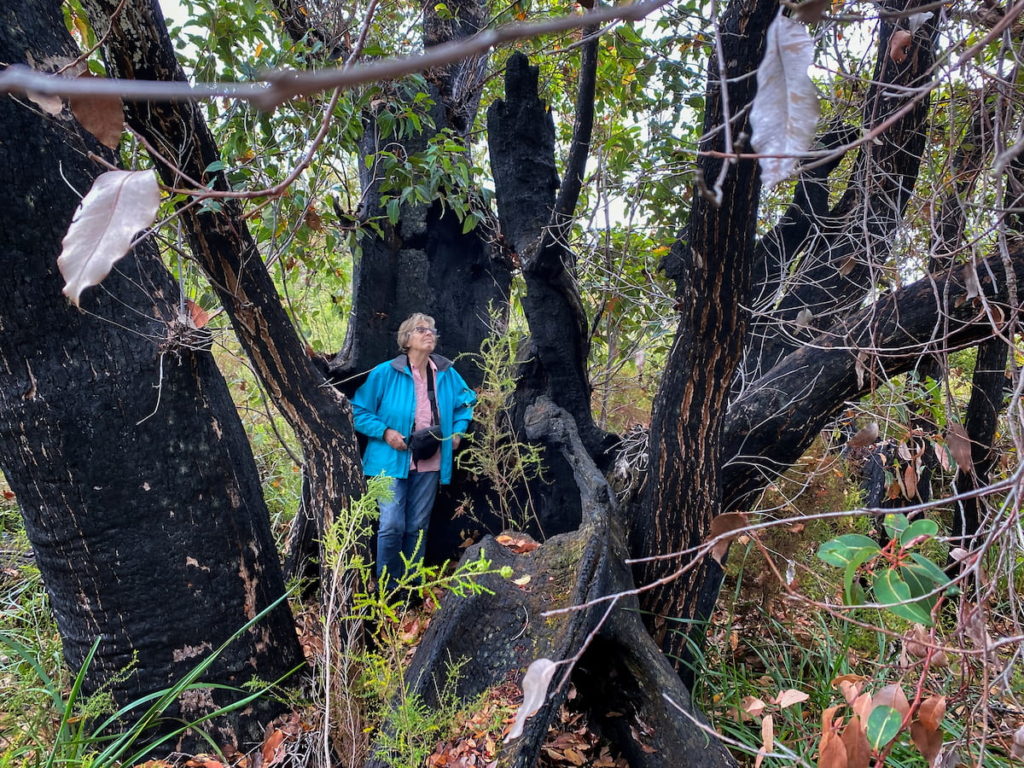
Professional foresters knew to keep fire out of commercial species until their trunks could withstand any damage from mild fire — for karri this was 15 to 25 years. For the Walpole Wilderness Area, some managers advocate even shorter fire rotations, but I feel that seedlings of tree species killed by prescribed fires will not have time to grow and establish.
It’s not just trees and forest ecosystems that are suffering from the impacts of prescribed burning. I’m keen for you all to know that much of the Walpole Wilderness Area is thick with various types of wetlands, including the peat systems. To borrow a phrase from Professor Pierre Horwitz, who studies wetlands, we should really view this area of high rainfall as wetlands interspersed by forest, rather than forest interspersed by wetlands.

I think it’s incredibly sad that it is now very hard to find a peat system in the Walpole Wilderness Area that has not been impacted by fire. Peat is flammable and forms over hundreds of years. If the substrate — consisting of old, old plant material — ignites, it then burns for months. It won’t recover because of all the changes to the soil chemistry and vegetation — and the feral pigs move in and dig around. In last year’s major prescribed burn in Mt Roe/Mt Frankland national parks, we know that a number of peatlands ignited and substrate has been lost.

The peat and wetland systems are where you find a lot of local endemic species with Gondwanan origins, like the Walpole burrowing crayfish Engaewa walpolea and the spectacular sunset frog Spicospina flammocaerulea. This frog species was unknown to science until found by Pierre Horwitz in the Walpole Wilderness Area in 1994. In another peatland, in 2018, members of the Parks Association found an orchid species previously unknown to science: the Walpole peat helmet orchid.

Recently, the Parks Association initiated a number of projects to survey and study the peats. I believe this ongoing focus on their protection is incredibly important — we are running out of time due to prescribed burning and a drying climate.
There’s a very special area within the Walpole Wilderness Area that I want to tell you about because I believe some of its special trees are now threatened by another prescribed burn. During Easter this year, I walked into the Soho hills area with a group of friends to get a closer look at what’s in there. The hills are part of the Soho forest block (see first map above), as it’s called by the Department. It’s where another endemic species of limited range — the rare Rate’s tingle Eucalyptus brevistylis — still grows.

I find the landscape very beautiful and very diverse — you don’t have to walk very far to go through many, many different vegetation and ecosystem types: there’s wetlands, heaths, different forest types including jarrah and marri in broad valleys, and granite outcrops. Once you walk up onto the granite, you get these amazing vistas out over the Walpole wilderness. And there’s terrific plant diversity in the area. In a 1991 field trip, botanist Dr Grant Wardell-Johnson found an incredible species diversity in just a 20 metre by 20 metre quadrant along a track.
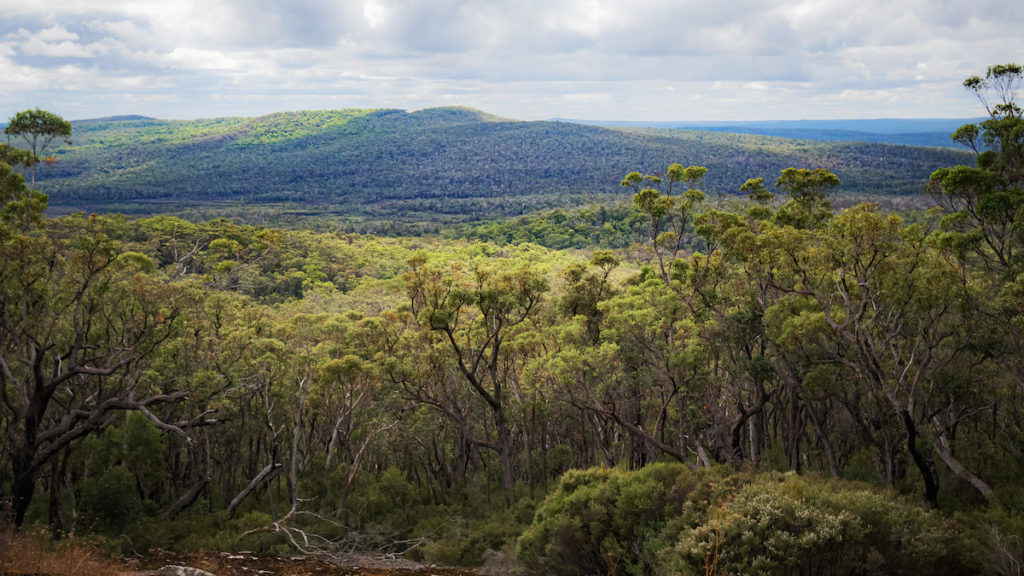
On our Easter walk into Soho, we all fell under the spell of the Rate’s tingles. On the granite outcrop, one exceptional old tree was photographed. It is one of the most special trees you will ever come across bushwalking across these hills.
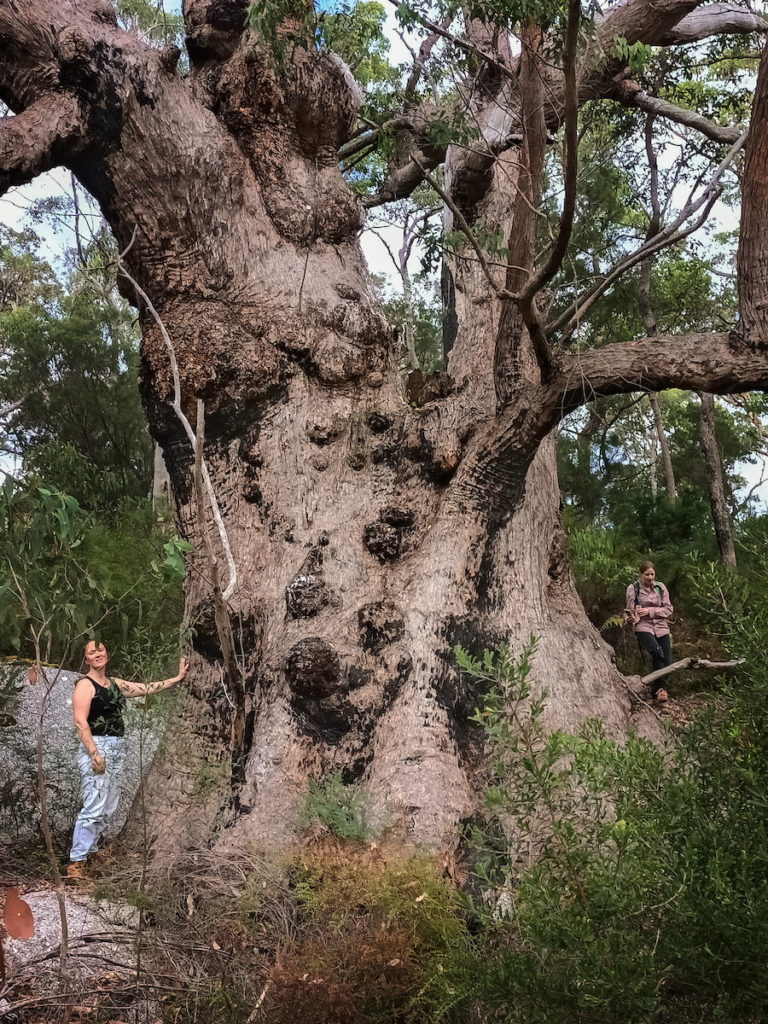
Like the famous red tingles of the Tree Top Walk, some of the Rate’s tingles have large buttresses, hollowed by fire, making them structurally unstable and vulnerable.
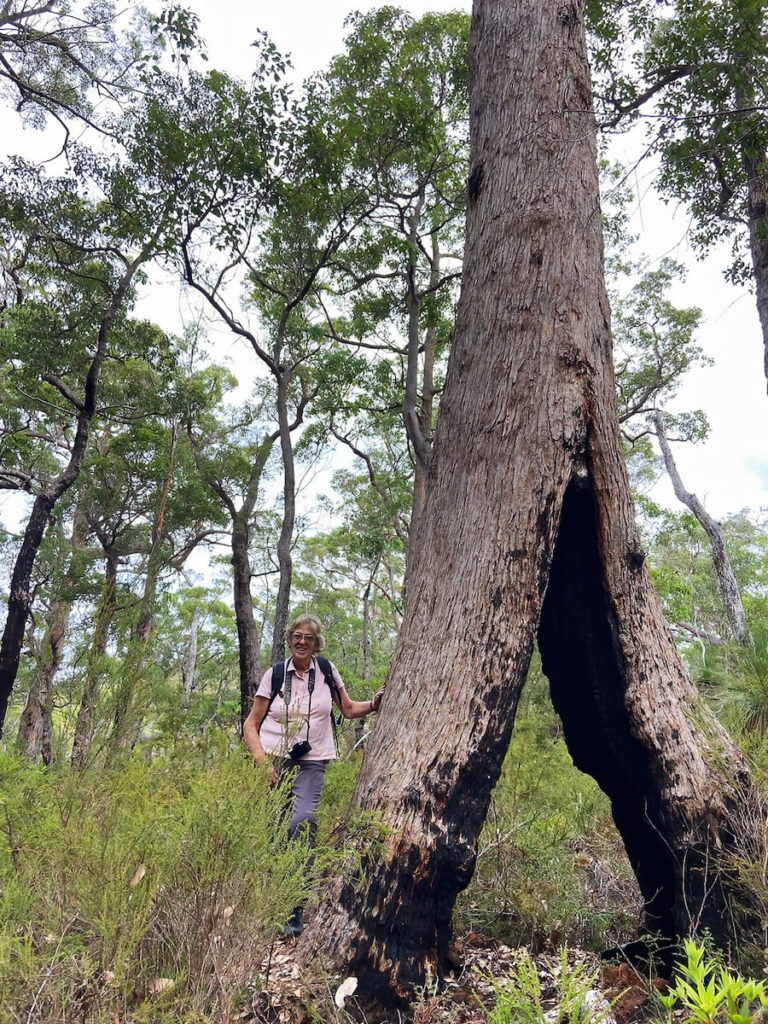
Unfortunately, Soho block is considered close to settlements, so it is basically being managed as an area of ‘fuel’, not as an area of incredibly high natural heritage values and biodiversity. Way back in 1992, the Parks Association had a meeting with the then Department of Conservation and Land Management about the fire management of Soho block, especially because of the presence of Rate’s tingle. All sorts of suggestions were made at that time, but if anything, the impacts of prescribed burning have got worse. Now there is an even more urgent need to assess how prescribed burning practices and ignition methods should be scaled back and adapted for the drying climate.
Worryingly, Soho is on the Department of Biodiversity, Conservation and Attractions’ burn list again for this year. It was burnt just eight years ago, in 2015 — it was an incredibly hot fire in some places and consequently, some of the peat systems were totally destroyed, some of the red flowering gums suffered significant structural change, and there’s very little recruitment of young gums. I have seen jarrah vegetation types in Soho where the tree crowns are really suffering and have evidently not recovered from the 2015 fire.
We need a reprieve on burning Soho block at least until we can really assess the ecological impacts and recovery from the last 2015 burn, as well as earlier burns. There is an urgent need for more monitoring.
Dieback spread can be a serious side-effect of fire management. Dieback, caused by the introduced soil-borne water mould Phytophthora cinnamomi, is already present in Soho block. Unfortunately, about 35 years ago, infected gravel was used in road maintenance in the area, and you can see how it is encroaching into areas of banksia woodland. When tracks were bulldozed to put out a peat fire that was burning during the 2015 prescribed burn, dieback was spread into the woodland, and you now see the lines of dying banksias.
In 2004, I helped to establish and then ran Project Dieback, one of the early programs to try and reduce the spread of this terrible plant disease in south-western Australia. Within the Walpole Wilderness Area, we identified some of the largest disease-free areas and tried to provide the Department with an idea of where they were so they would give them priority for protection in the long term. I fear that bulldozing associated with last year’s Mt Roe/Mt Frankland national parks burn, and its control, will have spread dieback into some of the last remaining disease-free banksia woodlands within the Walpole Wilderness Area.
For all the reasons above, I firmly believe that the methods of prescribed burning need urgent, expert, independent review. This review needs to include an assessment of the scientific evidence associated with prescribed burning. Fire prescriptions must be adapted for drying times and the voices of local communities should be heard. Government agencies tend to come up with blanket approaches which I believe are compromising the great biodiversity of the lands being managed. I am motivated to speak out because I have visited far too many areas where prescribed fires have left scenes no different from those after wildfires. We need to burn with care.
Given the yearly investment of many millions of dollars of public funds in prescribed burning, there should be a cost-benefit analysis. We need to see whether mitigating the risk of wildfires to people and property could be achieved through a better mix of approaches that also protects ecosystems, wildlife, plants and other species from the effects of both fire and climate change.
Tim Winton, our well-known Western Australian author, was recently quoted as saying, “I feel so lucky to live somewhere where there are still wild places — I think we take it for granted, because we don’t understand how rare and precious it is.” Similarly, I feel lucky but frustrated that too few people realise how precious the country of the Walpole Wilderness Areas is.
Although Ross and I now live closer to Albany, I still love going back to Walpole to walk in the beautiful old-growth red tingle forests both on the farm and in the nearby national park. While walking, I reflect that we cannot manage this Walpole Wilderness Area only out of our fear of fire; we must work to protect it from uninvited intrusions, like feral pigs and dieback, and manage it carefully to sustain its extraordinary values.
THANKS to Joanna Young, the photographers, map makers, and all the community members who kindly assisted with this story. Editing by Nicole Hodgson, Margaret Robertson and Keith Bradby; photo editing by Carol Duncan. Thanks also to the Southerly Magazine for publishing this story in the June 2023 edition.
FURTHER INFORMATION ABOUT PRESCRIBED BURNING
Impact on wildlife
ABC NEWS: Prescribed burn devastates one of WA’s last two endangered numbat habitats – ABC News (2 May 2021)
ABC NEWS: A prescribed burn in Western Australia has decimated one of only two numbat habitats | ABC News (4 May 2021; YouTube)
GWN7 NEWS: CALLS FOR INDEPENDENT PRESCRIBED BURN INQUIRY | Facebook (13 May 2021; video)
Emeritus Professor Don Bradshaw’s presentation to the Fire & Biodiversity Forum, 4 June 2021: ‘The impact of prescribed burning in southwest WA: a honey possum’s perspective’ (video, 23 min)
Humane Society International (Australia), ‘Analysing the Wildlife Toll of Prescribed Burning Practices in Southwestern WA: Impacts of Prescribed Burning on Fauna and their Habitats’ (August 2022) – available here
Impact on tingle forest
ABC NEWS: Calls to stop prescribed burning of tingle forest (4 April 2022; video)
Impact on peat swamps, the Walpole Wilderness Area and more broadly
ABC RN, ‘Off Track’: Are we burning in ignorance (19 Feb 2021)
ABC Landline: Striking the balance between hazard reduction burns and biodiversity (21 Feb 2021; iView)
ABC NEWS: WA’s prescribed buns threaten biodiversity amid climate change, scientists warn (20 Aug 2022)
ABC NEWS: ‘WA’s prescribed burning program ‘increasingly problematic’ (21 Aug 2022; video)
ABC NEWS: Scientists call for urgent review of prescribed burn practices (12 Dec 2022; video)
ABC NEWS: Scientists say WA government’s prescribed burns targets have no scientific basis – ABC News (11 May 2023)
Professor Kingsley Dixon’s presentation to the Fire & Biodiversity Forum, 4 June 2021, ‘Managing fire in the age of extinction’ (video, 22 min)
Other presentations at the Fire & Biodiversity Forum, 4 June 2021 (videos)
Professor Pierre Horwitz’s article in the Southerly Magazine and Gondwana Link’s Heartland Journey’s website: Sunset frogs in the cool and wet (June 2022)
Cultural burning
Elder Lynette Knapp, Ms Ursula Rodriques and Dr Alison Lullfitz at the Fire & Biodiversity Forum, 4 June 2021: ‘A natural blackfella thing, or hazard reduction, or both?’ (video, 23 min)
Dr Jim Underwood’s story in the Southerly Magazine and Gondwana Link’s Heartland Journeys website: Giving Fire Back to Goreng Country (October 2022)
ABC NEWS: Cultural burning carried out in Denmark after homes lost in February bushfire (12 May 2022)
